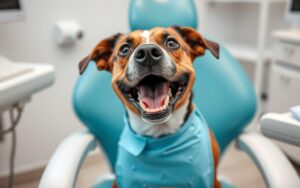
Imagine your energetic Labrador Retriever, the epitome of vigor, suddenly collapsing in the midst of play—an unexpected reality for approximately 3% of Labs worldwide. Known as EIC-Exercise-Induced Collapse in Labradors, this genetic condition poses significant Labrador Retriever health issues, disrupting the lives of lively canines and their devoted owners. As a loving Lab caretaker, understanding and managing EIC in labs is of paramount importance to safeguard the well-being of your four-legged family member.
Genes play a fickle hand in this disorder, with otherwise healthy dogs succumbing to weakness post-strenuous activity. The stakes of recognizing early symptoms and intervening with proper management strategies are high, not only for the health of your dog but also for the future of this beloved breed.
Key Takeaways: EIC-Exercise-Induced Collapse in Labradors
- Learn to identify signs of distress in your Lab as they indicate possible EIC.
- Recognize that EIC is a genetic disorder and not a result of poor fitness.
- Understand that while EIC can be life-threatening, it’s also manageable.
- Discover the importance of DNA testing and responsible breeding in preventing EIC.
- Explore adjustments in exercise regimens to safely work with Labs affected by EIC.
- Consider the implications of EIC for the wider Labrador Retriever population health.
- Testing For EIC With the DNA Dog Test
- What is EIC-Exercise-Induced Collapse in Labradors?
- The Genetic Science Behind EIC in Labs
- Identifying EIC Symptoms in Labrador Retrievers
- Labrador Retriever Health Panel Testing
- Managing Exercise-Induced Collapse in Labs
- Preventing EIC in Labs Through Responsible Breeding
- Risks and Misconceptions Surrounding Labrador Exercise
- Understanding the EIC Carrier State in Labrador Retrievers
- Exploring the Prevalence of EIC in Labrador Populations
What is EIC-Exercise-Induced Collapse in Labradors?
As a dedicated owner, understanding health conditions like EIC in labs is pivotal for the wellbeing of your furry companion. Exercise-Induced Collapse (EIC) in Labrador Retrievers presents a stark warning on the potential implications of strenuous activity. Defined by its characteristic loss of muscle control following exercise, EIC places significant emphasis on the prudent management of your dog’s physical exertion. Let’s delve deeper into the science behind this condition and its genetic underpinnings.
Defining the Phenotype of EIC
EIC in labs manifests through distinct symptoms ranging from mild to severe. Post-exercise, dogs may display signs such as difficulty standing, dragging of the hind limbs, or in severe cases, complete collapse.
This condition – predominately observed in Labrador Retrievers and related breeds – raises concerns about labrador health conditions and necessitates a closer look at canine exercise patterns. Now, let’s explore how EIC is transmitted genetically, a factor that significantly affects breeding choices and overall labrador retriever genetic disorders management.
The Mode of Inheritance and Impact on Labrador Health
The central risk factor for EIC lies in its mode of inheritance, where two copies of the defective allele must be present for a dog to exhibit the condition. This autosomal recessive trait can remain hidden in carriers, complicating breeding strategies to maintain the health and vigor of Labradors.
| Genotype | Resulting Condition | Implication for Labrador Health |
|---|---|---|
| E/E | Affected by EIC | May experience full collapse episodes post-exercise, requiring careful exercise management |
| N/EIC | Carrier (asymptomatic) | No symptoms; however, they can pass the condition to offspring if bred with another carrier or affected dog |
| N/N | Clear of EIC | Unaffected and cannot transmit EIC to offspring; ideal for breeding to ensure EIC-free litters |
This genetic predisposition to EIC necessitates thoughtful breeding choices, compelling breeders and pet owners to consider the implications of exercise and its potential to induce serious health events in susceptible dogs. Through genetic screening and careful observation of labrador health conditions, it’s possible to minimize the spread and impact of labrador retriever genetic disorders like EIC.
The Genetic Science Behind EIC in Labs
Delving into the genetic neuromuscular disorder known as exercise-induced collapse in Labrador retrievers, we discover a complex inheritance pattern that is at the forefront of canine genetic research. It’s an area that not only expands our understanding but also guides responsible breeding practices.
Autosomal Recessive Disorder Explained
Exercise-induced collapse (EIC) in Labrador Retrievers is caused by an autosomal recessive genetic trait. This means that a dog must inherit two copies of the defective gene, one from each parent, to fully express the disorder. Pups with just one copy become carriers without showing symptoms, unbeknownst to many owners until genetic screening is done. Awareness and understanding of this mode of inheritance are essential steps in containing the spread of EIC in Labradors.
Mutations of the DNM1 Gene and Their Effects
The culprit behind EIC in Labrador Retrievers is a DNM1 gene mutation, which plays a crucial role in nerve function. When this gene mutates, it can drastically affect a dog’s muscular control following rigorous exercise, leading to collapse. This table outlines the probabilities of producing affected or carrier offspring depending on the genetic status of the parents:
| Parent 1 (Genotype) | Parent 2 (Genotype) | Probability of Affected Offspring | Probability of Carrier Offspring |
|---|---|---|---|
| Clear (N/N) | Clear (N/N) | 0% | 0% |
| Clear (N/N) | Carrier (N/EIC) | 0% | 50% |
| Carrier (N/EIC) | Carrier (N/EIC) | 25% | 50% |
| Carrier (N/EIC) | Affected (EIC/EIC) | 50% | 50% |
| Affected (EIC/EIC) | Affected (EIC/EIC) | 100% | 0% |
Given these facts, your choices as a prospective Labrador Retriever owner or breeder are vital. Opting for genetic testing before breeding can prevent the unintentional propagation of EIC due to the DNM1 gene mutation, ensuring the health and vitality of this beloved breed for years to come.
Identifying EIC Symptoms in Labrador Retrievers
As a Labrador Retriever owner, it’s essential to be vigilant about your dog’s health during exercise, particularly in recognizing signs of Exercise-Induced Collapse (EIC). The ability to spot EIC symptoms in labs can help prevent serious labrador exercise risks and ensure the safety and wellbeing of your pet.
Characteristic Signs of Collapse
During or after periods of intense activity, be attentive to any changes in your Lab’s behavior or movement. Initial symptoms often present themselves in the form of rear limb weakness, which could be a precursor to more serious conditions. You might notice your dog showing difficulty in movement or even an inability to stand, a telltale sign warranting immediate attention.
Variations in EIC Severity and Symptoms
EIC can manifest in varying degrees of severity. Some labs may experience only a slight wobble in their gait, while others might completely collapse. Here are signs to watch for when recognizing EIC in Labrador Retrievers:
- Staggering or uncoordinated movements post-exercise.
- Dragged hind limbs despite an attempt to continue running.
- A noticeable elevation in body temperature following intense exercise.
Understanding these symptoms is critical for Labrador owners, as early intervention can greatly reduce the potential for life-threatening situations. Regular monitoring and appropriate adjustments to your dog’s exercise routine can mitigate the risks associated with EIC and provide peace of mind during play and training sessions.
Labrador Retriever Health Panel Testing
Understanding the genetic health of your Labrador Retriever is key to ensuring a long, joyful life for your furry companion. Advancements in veterinary science now allow pet owners and breeders alike to gain invaluable insights into potential hereditary conditions through dog DNA tests. These tests, which are part of a comprehensive Labrador retriever health panel, provide a window into your dog’s genetic blueprint, enabling proactive health care decisions.
Why DNA Testing is Crucial for Labs
Due to the Labrador Retriever’s predisposition to certain genetic conditions, such as Exercise-Induced Collapse (EIC), DNA testing becomes a non-negotiable part of responsible ownership and breeding. A simple cheek swab can reveal whether a Lab is affected, a carrier, or clear of the EIC mutation. With this information, you can make informed choices about your dog’s exercise routine, breeding options, and overall care.
Understanding and Interpreting Test Results
When you receive the results of your Labrador’s health panel, it’s crucial to understand what the abbreviations mean. An N/N result indicates your dog is void of the EIC mutation and clear of risk. An N/EIC result denotes a carrier status, meaning your dog has one copy of the mutation but is typically asymptomatic. Finally, an EIC/EIC result implies your dog has two copies of the mutation and is at risk for developing symptoms of EIC. To add transparency and trust to the breeding process, these results can be annexed to OFA submissions for labrador health. This documentation is invaluable and helps maintain the integrity of the breed by ensuring potential new owners are aware of the health status of their future pets.
Becoming informed about the genetic health of your Labrador Retriever is integral to your role as a responsible pet owner or breeder. Utilizing DNA testing can safeguard the wellbeing of not just your own dog but the breed as a whole.
Managing Exercise-Induced Collapse in Labs
Living with Exercise-Induced Collapse (EIC) in Labrador Retrievers requires awareness and adaptation. Through proactive management, you can provide a safe and fulfilling lifestyle for your furry companion. Starting with recognition and quick response to the signs of EIC, you can prevent a full-blown episode from occurring.
Proper Exercise and Precautions for Affected Dogs
Safe exercise for Labrador Retrievers with EIC doesn’t mean no exercise. Establishing a routine that combines moderate physical exertion with careful monitoring can help maintain your Lab’s health without risking an EIC event. Short, controlled play sessions, especially in cooler environments, can prevent over-exertion. Include rest periods and maintain hydration to manage your Lab’s excitement and stress levels during exercise.
Remember, preventing EIC is not about limiting your Labrador’s life but adapting it to ensure they remain healthy and active without the risk of collapse.
Lifestyle Adjustments for EIC Management
Beyond exercise, managing EIC in labs extends to everyday life. Here are some lifestyle adjustments that can make living with EIC easier for both you and your dog:
- Avoid situations that may cause excessive excitement or stress.
- Consider a diet plan that supports muscle health and consult your vet for supplements that may aid in muscle recovery.
- Stay vigilant for early symptoms such as hind leg weakness, and take immediate action by ceasing exercise and initiating cool-down procedures.
- Discuss with your veterinarian the potential benefits of medications like Phenobarbital and whether they may be suitable for managing your Lab’s EIC.
- Neutering may also be considered as it has shown benefits for some affected males by potentially reducing excitement-induced stress.
Embracing these steps can pave the way for a healthy balance, letting your Lab enjoy a good quality of life while managing their EIC effectively.
Preventing EIC in Labs Through Responsible Breeding
As someone who cherishes the well-being of Labrador Retrievers, you recognize the significance of preventing EIC in labs. One effective strategy lies in the realm of responsible labrador breeding, which is essential for nurturing EIC-free Labrador Retrievers. By integrating comprehensive DNA testing protocols, breeders are empowered to establish the genetic health of their canine counterparts.
Avoiding the pairing of two carriers is a fundamental rule in responsible breeding. Yet, with the current scientific advancements, breeders are not merely avoiding combinations; they are actively steering genetics towards a healthier future for the breed.
Essential responsible breeding practices comprise of breeding carrier Labradors only with clear dogs, thereby completely ruling out the possibility of bringing affected puppies into the world.
Although not every Labrador with two copies of the EIC gene mutation will experience collapse, eliminating these genes from the breeding pool can substantially reduce the occurrence of EIC. Implementing such precautions effectively safeguards the lineage, assuring vitality for generations to come.
- Use DNA testing to determine EIC status before breeding.
- Never breed two carriers or an affected dog to a carrier.
- Breed carriers exclusively with dogs clear of the EIC mutation.
- Consider the overall genetic diversity and health of the Labrador population.
While the route to an EIC-free generation is scientific, the commitment remains deeply ethical. As stewards of the breed, Labrador Retrievers’ caretakers hold the key to phasing out Exercise-Induced Collapse through thoughtful and informed breeding decisions. The path to EIC prevention in Labs is clear: breed judiciously, test rigorously, and prioritize the health of your dogs above all else.
Risks and Misconceptions Surrounding Labrador Exercise
When it comes to understanding labrador exercise risks, the concept of regular activity for dogs is universally encouraged. However, not every owner is fully aware of the specific challenges associated with exercise-induced collapse in labrador retrievers (EIC). This condition is not exclusive to unfit or unhealthy animals; it can affect top-performing, highly athletic dogs just as easily. Due to this, learning about and mitigating EIC triggers becomes an essential aspect of caring for your energetic companion.
Unpacking the misconceptions surrounding intense physical activity for Labs is imperative. The collapse associated with EIC often occurs in scenarios that combine vigorous exertion with heightened excitement. To promote a safer exercise regime, you should moderate both the intensity of the activity and the overall environment to decrease the chances of an EIC event. Being mindful of these considerations helps prevent undue stress on your dog, ensuring their well-being during exercise.
- Recognize that EIC can affect any Lab, regardless of athletic prowess
- Identify activities that are highly excitatory, as these could act as triggers
- Gradually increase exercise intensity to monitor your dog’s tolerance
With these strategies, you’ll have a better chance of crafting an exercise routine that keeps your Lab both fit and safe.
Understanding the EIC Carrier State in Labrador Retrievers
If you’re involved in the Labrador Retriever community or are a meticulous pet owner, understanding the significance of genetic screening for labrador health, especially concerning the EIC carrier state, is crucial. Exercise-Induced Collapse (EIC) can impact the well-being of one of America’s favorite breeds, and unraveling the function of carriers helps reduce EIC incidence in Labradors. Knowledge is power—and it becomes a powerful tool when dealing with inheritable conditions in dogs.
The Role of Carriers in EIC Propagation
To comprehend the intricate web of Labrador genetics, it’s important to recognize that carriers of EIC, though symptom-free, can silently pass on the mutation. Each carrier has one copy of the mutated DNM1 gene, which doesn’t affect them directly but can significantly influence the genetic makeup of their potential offspring. Such carriers are the silent propagators, making EIC carrier state in labs a critical focus of responsible breeding.
Strategic Breeding to Minimize the Spread of EIC
Reducing the EIC’s footprint in Labrador populations involves informed and strategic breeding decisions. Here’s where genetic screening becomes a beacon of hope. Assessing the carrier status of each breeding candidate plays a pivotal role. This table outlines a safe breeding guide based on EIC carrier status:
| Parent 1 Status | Parent 2 Status | Potential Outcome for Puppies |
|---|---|---|
| EIC Carrier (1 EIC gene) | Clear (0 EIC gene) | 50% Carriers, 50% Clear |
| EIC Carrier (1 EIC gene) | EIC Carrier (1 EIC gene) | 25% Affected, 50% Carrier, 25% Clear |
| Clear (0 EIC gene) | Clear (0 EIC gene) | 100% Clear |
| Affected (2 EIC gene) | Clear (0 EIC gene) | 100% Carriers – No affected puppies |
As shown, the optimal practice is to breed carriers or affected dogs (those with two EIC genes) only with clear dogs. This helps minimize the spread of EIC in Labradors, benefiting the breed for generations to come. By narrating each potential carrier’s genetic story, breeders can curate healthier pedigrees, and owners can embrace a more informed relationship with their beloved Labs.
Exploring the Prevalence of EIC in Labrador Populations
The health of our cherished Labrador Retrievers remains a priority for breeders and pet owners alike. A significant concern within this community revolves around the prevalence of EIC in labs. A staggering near 40% of Labrador Retrievers are carriers (E/N) of Exercise-Induced Collapse, a genetic disorder that can significantly impact a dog’s well-being. Alarmingly, approximately 6% of the population faces the troubling reality of being affected (E/E), putting them at risk for potentially life-threatening collapse episodes.
Consider this: EIC is not selective, affecting not only highly active dogs participating in field trials or hunt tests but also those in the show ring and companions at home. Such widespread distribution underscores the importance of genetic health screening as a proactive approach to managing and eventually reducing the incidence of exercise-induced collapse in Labrador Retrievers. Your role in this initiative is crucial—whether you’re a lover of the breed, a proponent of canine health, or a dedicated breeder.
Armed with the statistics highlighting the prevalence of EIC in labs, your informed decisions can shape the future of many Labrador Retrievers. Emphasizing the necessity of genetic screening is a leap toward better health outcomes and more transparent breeding practices. By understanding the genetic landscape of Exercise-Induced Collapse within the Labrador Retriever population, you can contribute to a community that values the genetic integrity and lasting health of this beloved breed.




















